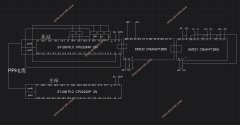小型锅炉S7-200控制系统设计

1.无需注册登录,支付后按照提示操作即可获取该资料.
2.资料以网页介绍的为准,下载后不会有水印.资料仅供学习参考之用.
密 惠 保
小型锅炉S7-200控制系统设计(任务书,论文11000字,CAD接线图)
摘要
本次毕业设计详细介绍采用基于西门子S7-200实现对小型锅炉内液体的液位、温度和气压的控制,同时触摸屏采用WINCC软件对小型锅炉的液位、温度和气压进行实时监控。本次毕业设计以锅炉为主被控对象,以S7-200PLC为控制器,构成锅炉控制系统。本次小型锅炉的控制系统采用PID算法,运用STEP7进行编程,从而可以实现对锅炉温度、气压、液位的自动控制。上位机通过WINCC对小型锅炉实施监控。并运用利用两台S7-200PLC构建网络架构,一台PLC接收输入信号,并传送至另外一台,另外一台设计控制方案对温度和液位进行控制。并于实际工业锅炉相联系,运用MATLAB仿真软件对工业锅炉进行仿真模拟。
关键词:S7-200PLC; WINCC; PPI; MATLAB仿真
Control And Realization of S7-200 Control System on Small
Boilers
Abstract
The graduation design introduce that Siemens S7-200 PLC take control of the small boilers with water level,temperature and pressure , while the touch screen used WINCC software monitoring the small boiler with water level ,temperature and pressure in real time . The boiler control system consist of the boiler is controlled object and PLC is the controller in the graduation design. The small boiler control system using PID algorithm, using STEP7 to write program, which can be realized the automatic control of the boiler temperature, pressure and liquid level. Upper computer through WINCC monitoring the small boilers. And use two sets of S7-200 PLC built PPI network, one receives input signals and the others sent to another one, one design control scheme with temperature and level. And linked to industrial boilers, using MATLAB simulation software for the simulation of industrial boilers.
[资料来源:www.THINK58.com]
Key Words:S7-200PLC; WINCC;PPI;MATLAB
[来源:http://www.think58.com]

目录
摘要 I
Abstract II
第一章 绪论 5
1.1课题背景及研究目的和意义 5
1.2 锅炉控制系统应用现状 6
1.3 系统设计的主要内容 6
第二章 小型锅炉PLC控制系统的软件设计 8
2.1 PLC的应用与发展 8
2.2 小型锅炉工艺过程简介 9
2.3 系统总体设计 9
2.4 软件设计 11
2.4.1 PID算法原理 12
2.4.2 I/O分配情况 12
2.4.3 控制程序实现 13
2.5 调试结果 20
第三章 对小型锅炉监控画面的设计 23
3.1 WINCC的发展和背景 23
3.2 WINCC的功能与特点 23
3.2.1 WINCC的功能 23
3.2.2 WINCC的特点 24
3.3 WINCC的监控画面设计 24
第四章 两台S7-200 PLC之间的PPI通信 29
4.1 PPI通信的协议 29
4.2 小型锅炉PPI网络通信控制系统设计 29
4.3 PPI网络控制实现 30
4.4 PPI通信的控制结果 32
第五章 MATLAB对工业锅炉的仿真 34
5.1MATLAB的发展和应用 34
5.2 PID控制的原理 34
5.3被控对象的建模 36
5.4 PID控制仿真实验 37
总结 39
参考文献 40
致谢 42
